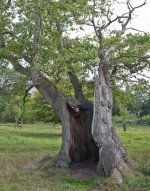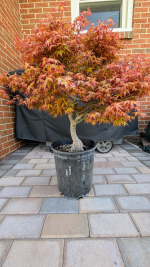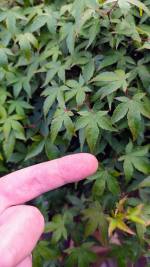@The Barber Thanks man. That's awesome. Yeah, you really love those massive trees and I love to see it!
I really need to make a weekend yamadori road trip.
Most of them aren't as massive as they look. I swear I prefer smaller trees, occasionally big specimens just have their own gravity and they pull me in.

To stay on topic, and to back up your claims, here's one way to get large old material,
for free, which is my favorite price. Unless you count how much work that extraction will be, and about a mile hike, mostly uphill carrying it will be extra fun. This is a very old dogwood (Cornus Florida) with a 12 inch base that I've been contemplating as a heavily carved and fully hollowed trunk, which hopefully it would reduce the weight significantly. It would be chopped back in the neighborhood of what you see in this photo. I have always loved how petite dogwoods are, but the way they branch and the leaf size, I feel would be better suited for a large tree, so petite is out the window. I have been looking for a dogwood with a base with character for a while, most Cornus Florida usually are just very plain, straight upright growing and lack character. Developing a thick trunk with taper would take forever on this species as well, they grow very slow, so I have a game plan, one that could easily be used on another species. This is just an example of what you can do with large material.
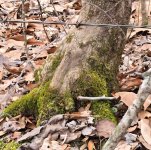
Interestingly, it only has 5 branches that reach out of the edge of the woods. Probably a 25ft tall tree or better (for now).
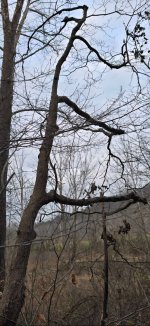
A tree of this size will require at least a couple years of work to be 100 percent sure that there will be feeder roots near the trunk though.
The 1st spring I will chop the trunk back to around 20 inches or so and seal the cut really well so that the tree can respond by growing new branches during the growing season. Then I will use my sawzall, about 1 to 2 ft from the base, and cut a half circle. I will most likely trench the cut side and dig under the root ball and attempt to cut any tap root and work on the large roots near the cut. Then I will loosen up the topsoil and mix in some Osmocote or another slow release fertilizer so that more oxygen can get into the forest soil. This should improve the soil on the cut side and encourage feeder roots to grow. Theoretically the roots on the other side of the tree will remain intact to keep the tree healthy while the cut roots respond by producing new feeder roots into the trench soil.
The second spring I will prune the new growth if need be, also checking to make sure the wound is still sealed well. Cut the half circle on the opposite side of the previous spring, trench, repeat.
The 3rd spring theoretically the tree will be safe for collection with about as minimal risk of losing the tree as possible
I will not be creating deadwood like the yamadori Yaupon Holly in the picture below has, I doubt dogwood deadwood would last long. What I do plan is to hollow it similarly to create taper, then let it roll over and into the hollow eventually. Years of natural decay on a tree in the wild like this yamadori has endured can be replicated through the use of pretty much a diagonal cut and some carving tools.

If you are willing to put forth the effort, you can create the appearance of age, and taper from even a mediocre stuml,
for free. Look for one with a bit of root flare and a nice nebari. There are many ancient oaks in Europe that I like to study for inspiration sometimes, it goes to prove that even a thick trunk without taper can be used to create bonsai similar to many of the ancient hollow trees you'll find in nature.
Bonsai doesn't have to be expensive, not everyone can afford to buy highly refined trees. This is just one way, among the many many ways you can go about create a really interesting tree on a budget, and saving many years of trunk grow out. Thankfully Europe is full of ancient oaks. I look at old trees in nature, in photos, and contemplate ways to recreate what nature does best. With old, large material I feel like you have to visualize the tree within the tree, and remove material till you have a good foundation to build upon, similar to how I would cut an overgrown haircut down to something excellent.
Hope this inspires some folks, and maybe gets a few to think outside the box.
